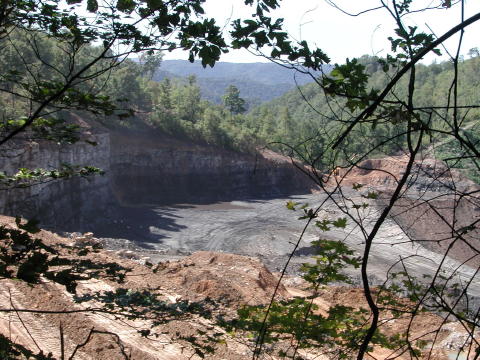MOUNTAIN SCARS WITNESSED BY VA TECH STUDENTS

Virginia Tech Students Witness The Scars Caused By Mountaintop Coal Mining At Kayford Mountain, W.Va.
Story by Don Simmons Jr. - Photos by Matt Gentry
Tuesday, November 16, 2004
The Roanoke Times Betsy Bernard stared at the scarred landscape in disbelief as dump trucks two-stories tall carried away load after load of what used to be a mountaintop.
"I don't understand how that can happen in the first place," said the Virginia Tech senior, staring out over terraces striped in yellow ochre dirt, black coal and gray rock that stretched for at least a thousand acres 200 feet below.
Piles of rocks as big as a Volkswagon Beetle lay at points along the open pit. Peaks that used to soar above her vantage point in 45-degree angles had been flattened. The refuse was tipped into the valleys below and sprayed with gray-green hydro-seed grass, all according to federal reclamation guidelines.
Larry Gibson had warned the 18 Virginia Tech Appalachian Studies students about the view as they neared the finish of a three-hour bus trip from Blacksburg to Kayford Mountain, W.Va. Gibson still owns about 50 acres on one of Kayford's peaks.
The view from his family cemetery reveals 360 degrees of ruin caused by what the coal industry calls the most modern and efficient means of harvesting the Appalachian coal crop.
Gibson, 58, came to Blacksburg last week to tell Tech students about the human and environmental costs of coal, which supplies slightly more than 50 percent of the nation's electricity.
"I used to have to look up in every direction from my mountain to see the sky," Gibson told professor Sam Cook's class last Thursday morning. "Now it's the highest peak for miles."
On Saturday's bus trip, the students got to see for themselves.
Expressions of shock began to voice themselves soon after the bus pulled off the turnpike at Sharon and began its run up the hollow along Cabin Creek. Rundown houses gave way to wooded hollows haunted by trickles of sulphur-yellow water. Peeks at yellow dirt cascading over edges that should have continued upward hinted at what was to come. Around one bend, the entire busload craned their necks to the left as an 800-foot-high valley fill - where what was once a V-shaped hollow was suffocated in waste material from the mines above - came into view.
As the bus snaked its way up Kayford Mountain, slowly climbing above some of the operating mine sites, the scenes became more frequent, more unnatural, more brutal. For five years Cook has taken his Appalachian Studies students on this field trip to Gibson's homestead. It's part of his goal of trying to build their consciousness, open their eyes.
"I want them to see the human cost of mining, but also how we're all dependent on it, too," Cook said. "It's a chance for my students to hear voices they won't otherwise hear and think about the future."
Bernard is thinking about it. After the trip, the aspiring English teacher said she would definitely be willing to go on an organized lobbying trip to Washington, D.C., to try to influence votes on a bill that could help lessen and slow the impact of what the coal industry now euphemistically calls "peak reduction" mining.
"Seeing it was shocking and appalling and I don't want something like that happening here," said Bernard, a Blacksburg native who enjoys hiking in her down time. "The people who have the money are really making the decisions about what's allowed and that's really scary and wrong."
Not every student left Kayford Mountain with such passion, but most seemed to feel they had seen something intrinsically wrong.
"I don't see you could keep living here without constantly fighting," said Drew Harrison, a Tech freshman from Bedford, noting the bullet holes in Gibson's camper at the Stanley Heirs Foundation Park.
Though the trip made Gibson's fight more personal, Harrison called it ultimately a losing battle.
"If the coal company can make $450 million from his mountain like he says, in 20 years it will be 300 feet lower and nothing will be left," said Harrison. "You might slow it down, but there's no way to stop it. There's too much money involved and for a lot of the families here it's about food on the table."
Kristine Bronnenkart, a Tech freshman from Pearisburg, said the trip convinced her that mountaintop mining was "terrible for the environment," but she remained skeptical about her ability to have an impact.
"If I was him [Larry Gibson], I just don't think I would want to stay. It's all been ruined."
Undeterred, Gibson told the students there are more important things in life than money and peace of mind.
"Why not let it go?" he asked, then answered himself. "Because in that cemetery up there are buried members of my family as far back as the 1700s.
"Y'all aren't just students," he implored. "One day some of you will be in positions of power. It might not be in time to save my mountain, but maybe you can bring attention to this cancer on the land and prevent it from happening somewhere else."